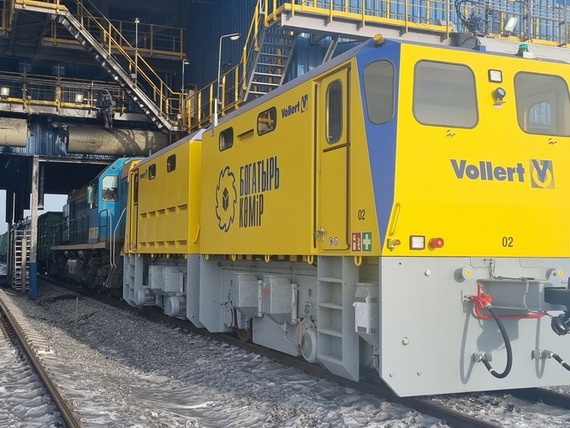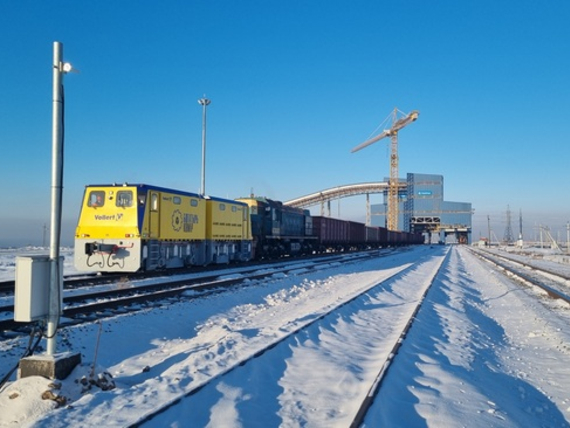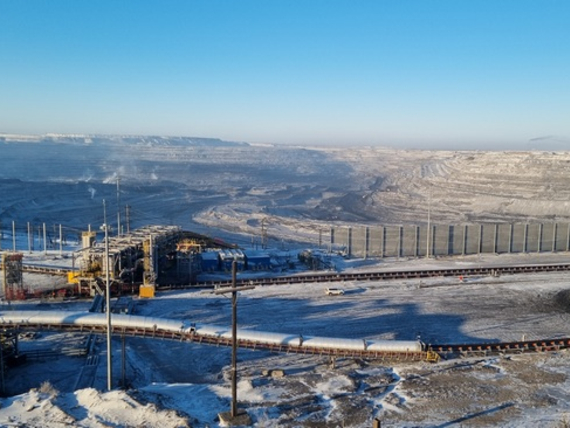Bogatyr is planning to expand the production capacity of Kazakhstan’s largest open-cast coal mine from 32 million tons to 40 million tons per annum with automated conveyor technology. The modernization project included erection of an automated coal wagon loading station in cooperation with ThyssenKrupp. It only takes three to four hours to load two trains with about 70 cars each in parallel. The trains are pulled automatically by five Vollert DER 300 shunting robots with diesel-electrical drives, traction forces of 300 kN each, and service weights of 150 tons.
Extreme demands to technology
Each of the five shunting machines comprises a six-axle tandem version with control and engine cars, and a drive output of 180 kW. A CAT generator adjusted to the specific requirements on site provides the power needed to operate the system. Temperatures from -30 to +30 °C and temperature fluctuations of +/- 30 °C in the course of a day demand tried and tested, robust technology. Vollert ensures smooth operation even under harsh climate conditions with heated components, a diesel tank integrated into the frame, automatic couplings, and a sanding system. All commissionings were performed in time at 33 °C before Vollert’s technology perfectly mastered its load tests.
Automated loading in operation
Delivery to the loading track happens manually, using a radio remote control. The shunting robot will stop automatically in its defined position, where the operator will initiate handover of Wi-Fi control to the staff in the loading building. With the empty freight train and its locomotive coupled to it, the shunting robot will move into the loading building to place the first wagon under the loading chute. Once loading is started, coal will be conveyed into the wagons continually, completing the process of loading in no more than three hours. The line locomotive will take over the train again at that point to transport the coal to the customer, while the shunting robots go on their way to take over the next train.
Control by Wi-Fi
Vollert used Siemens components to build a Wi-Fi route along the 1.3-km-long shunting tracks for data transmission and control. Eleven access points with directional antennae, connected by optical fiber, reliably forward the control unit’s data signals to the machines and vice versa. The Wi-Fi control also permits free operation of all robots on all tracks, enabling rolling use of the five shunting robots on four tracks and warranting failsafe operation around the clock. Each robot has remote maintenance integrated for 1st level support from Germany. Vollert also offers its customers the option of performing recurring inspections and maintenance on site.
Transport paths of more than 6,000 km
This project is the largest single order to date in the shunting systems portfolio of Vollert, a company that has existed for nearly a full century. Train loading was officially put into operation in December 2022, with full operation planned for mid-2023. Before the shunting robots were able to take up their work, however, Vollert organized their transport across more than 6,000 km to Ekibastuz – on land, on water, and by rail. Heavy-duty low-loaders carried the ten tandem parts with a total weight of 750 tons to Kiel, from where a ship took them across the Baltic Sea to Lithuania, to be transported on to Kazakhstan by train on a route spanning another 4,000 km.



